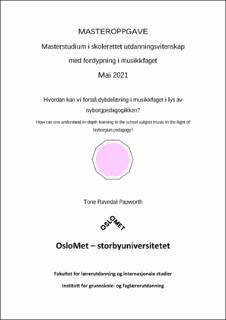| dc.contributor.advisor | Rinholm, Hanne | |
| dc.contributor.advisor | Evang, Hanne Kihlman | |
| dc.contributor.author | Papworth, Tone Ravndal | |
| dc.date.accessioned | 2021-10-14T10:44:41Z | |
| dc.date.available | 2021-10-14T10:44:41Z | |
| dc.date.issued | 2021 | |
| dc.identifier.uri | https://hdl.handle.net/11250/2822965 | |
| dc.description.abstract | Fagfornyelsen som trådte i kraft høsten 2020 peker på at skolene skal gi rom for dybdelæring (Utdanningsdirektoratet, 2020c). I den forbindelse ønsker jeg å undersøke hvordan dybdelæring i musikkfaget kan forstås i lys av nyborgpedagogikken, og hvordan lærere kan legge til rette for slik dybdelæring. Studien er hovedsakelig en utredningstekst med empiri bestående kun av skriftlige tekster hvor en hermeneutisk fremgangsmåte har blitt benyttet. Dybdelæringslitteraturen er preget av Udirs dybdelæringsdefinisjon, men begrepet drøftes i denne oppgaven også i lys av annen litteratur. Utredningen munner ut i en forklaringsmodell for hvordan elevenes forståelse dannes og kan brukes. Denne modellen blir konkretisert i en fiktiv case der et undervisningsopplegg om det musikkfaglige temaet «rytme» gjennomføres i en tenkt femteklasse. Forklaringsmodellen kan også anvendes som et redskap til å forstå hvor i dybdelæringsprosessen elevene til enhver tid er, slik at læreren kan legge til rette for neste hensiktsmessige steg. Denne oppgaven har til hensikt å skape bevissthet om hvordan en dybdelæringsprosess kan forløpe, og om hvordan lærere kan identifisere, underveisvurdere, og legge til rette for dybdelæring i musikkfaget. The new National curriculum that was implimented in autumn 2020 states that schools should make space for in-depth learning (Utdanningsdirektoratet, 2020c). Following this statement, I have investigated how in-depth learning can be applied to music education, by bringing in elements from the Nyborgian pedagogy. I also look at how this understanding could help teachers use in-depth learning in practice. This is an explanatory text study using a hermeneutic approach. Different definitions of in-depth learning existing in the literature are discussed. A part of this study is strongly influenced by the Norwegian Directorate for Education and Training’s definition of in-depth learning. The investigation concludes with an explanatory model explaining how I percieve that pupils aquire understanding, and how this understanding can influence further learning. The model is applied to a fictive case with a teaching scheme for the musical topic “rhythm” in a fifth-grade class (10 years old). This explanatory model can also be used as a tool to evaluate the pupils’ progress in the process of in-depth learning. The teacher can then consciously choose the next step in the process of in-depth learning. This report aims to demonstrate how a process of in-depth learning can happen and how teachers can identify, continuosly assess and enhance in-depth learning in music education. | en_US |
| dc.description.abstract | The new National curriculum that was implimented in autumn 2020 states that schools should make space for in-depth learning (Utdanningsdirektoratet, 2020c). Following this statement, I have investigated how in-depth learning can be applied to music education, by bringing in elements from the Nyborgian pedagogy. I also look at how this understanding could help teachers use in-depth learning in practice. This is an explanatory text study using a hermeneutic approach. Different definitions of in-depth learning existing in the literature are discussed. A part of this study is strongly influenced by the Norwegian Directorate for Education and Training’s definition of in-depth learning. The investigation concludes with an explanatory model explaining how I percieve that pupils aquire understanding, and how this understanding can influence further learning. The model is applied to a fictive case with a teaching scheme for the musical topic “rhythm” in a fifth-grade class (10 years old). This explanatory model can also be used as a tool to evaluate the pupils’ progress in the process of in-depth learning. The teacher can then consciously choose the next step in the process of in-depth learning. This report aims to demonstrate how a process of in-depth learning can happen and how teachers can identify, continuosly assess and enhance in-depth learning in music education. | en_US |
| dc.language.iso | nob | en_US |
| dc.publisher | OsloMet - Storbyuniversitetet | en_US |
| dc.subject | Dybdelæring | en_US |
| dc.subject | Musikkfag | en_US |
| dc.subject | Nyborgpedagogikk | en_US |
| dc.subject | Nyborg, Magne | en_US |
| dc.subject | Forståelser | en_US |
| dc.subject | Mestring | en_US |
| dc.subject | Progresjon | en_US |
| dc.subject | In-depth learning | en_US |
| dc.subject | Music education | en_US |
| dc.subject | Nyborgian pedagogy | en_US |
| dc.subject | Understandings | en_US |
| dc.subject | Mastery | en_US |
| dc.subject | Progression | en_US |
| dc.title | Hvordan kan vi forstå dybdelæring i musikkfaget i lys av nyborgpedagogikken? | en_US |
| dc.title.alternative | How can one understand in-depth learning in the school subject music in the light of Nyborgian pedagogy? | en_US |
| dc.type | Master thesis | en_US |
| dc.description.version | publishedVersion | en_US |
| dc.source.pagenumber | 129 | en_US |
| dc.subject.nsi | VDP::Samfunnsvitenskap: 200::Pedagogiske fag: 280::Fagdidaktikk: 283 | en_US |
